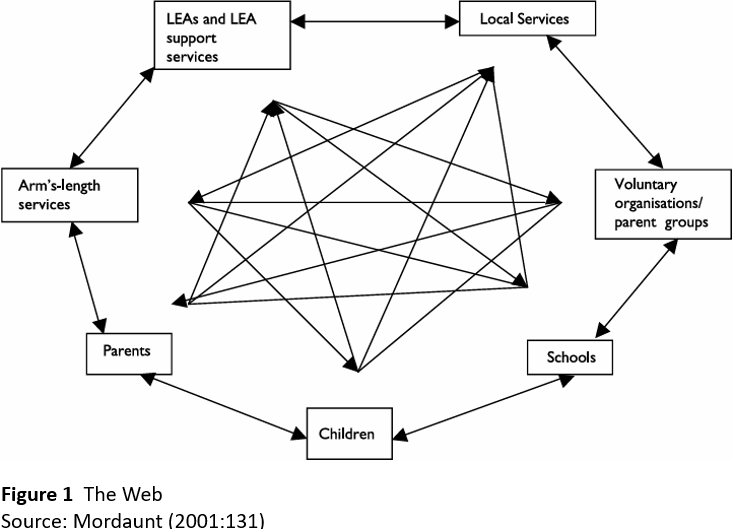


 Grammar
Grammar
 Tenses
Tenses
 Present
Present
 Past
Past
 Future
Future
 Parts Of Speech
Parts Of Speech
 Nouns
Nouns
 Verbs
Verbs
 Adverbs
Adverbs
 Adjectives
Adjectives
 Pronouns
Pronouns
 Pre Position
Pre Position
 Preposition by function
Preposition by function 
 Preposition by construction
Preposition by construction
 Conjunctions
Conjunctions
 Interjections
Interjections
 Grammar Rules
Grammar Rules
 Linguistics
Linguistics
 Semantics
Semantics
 Pragmatics
Pragmatics
 Reading Comprehension
Reading Comprehension|
Read More
Date: 2025-03-27
Date: 2025-03-29
Date: 2025-04-07
|
Partnerships
It is important therefore that all those involved in any partnership fully understand what this really means and involves. Mordaunt (2001: 131) constructed a model called ‘the Web’, based on the proposed SEN Code of Practice (DfEE, 2000) (Figure 1) to demonstrate ‘a more developed understanding of partnership, one which depends on the interconnected policies of all the players involved in the procedures and implies a greater sense of equality between all players’.
The SEN Code of Practice (DfES, 2001: 4,1:7) adds a further dimension to the idea of partnership. In the section entitled ‘Strategic Planning Partnerships’ it says:
Meeting the needs of children and young people with SEN successfully requires partnerships between all those involved LEAs, schools, parents, pupils, health and social services and other agencies. Partnerships can only work when there is a clear understanding of the respective aims, roles and responsibilities of the partners and the nature of their relationships, which in turn depends on clarity of information, good communication and transparent policies.

Understanding the roles and responsibilities of the partners and the nature of the relationships is of paramount importance if the risk of feelings of anxiety and hostility, as well as ineffectual interventions, is to be greatly reduced. Wall (2003: 71) agrees with these warnings: ‘Sometimes confusions arise or misconceptions exist because of a lack of coordination and collaboration which can compound a child’s difficulties.’
|
|
|
|
للعاملين في الليل.. حيلة صحية تجنبكم خطر هذا النوع من العمل
|
|
|
|
|
|
|
"ناسا" تحتفي برائد الفضاء السوفياتي يوري غاغارين
|
|
|
|
|
|
|
بمناسبة مرور 40 يومًا على رحيله الهيأة العليا لإحياء التراث تعقد ندوة ثقافية لاستذكار العلامة المحقق السيد محمد رضا الجلالي
|
|
|